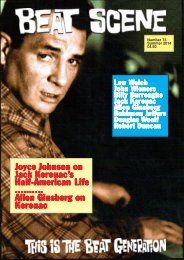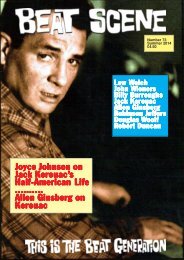Create successful ePaper yourself
Turn your PDF publications into a flip-book with our unique Google optimized e-Paper software.
Robert Duncan, Jess, and Friends<br />
range of artists, many from the California School of<br />
Fine Arts, and, as Christopher Wagstaff noted in an<br />
exhibition just on the gallery, artists were often paired<br />
who would contradict each other. And for the<br />
opening show, in addition to the uneven hanging of<br />
the artwork and murals painted on the walls creating<br />
a Dr. Cagliari imbalance, Miriam Hoffman’s<br />
sculptures created further dimensionality. And Jess<br />
later displayed a number of “Necrofacts,”<br />
assemblages of “real junk off the rubbish pile” in the<br />
gallery. But the gallery was also the venue for poetry<br />
readings for the likes of Jack Spicer, Philip Lamantia,<br />
Kenneth Rexroth, and Weldon Kees (who worked in a<br />
wide range of arts and music). Stan Brakhage’s first<br />
two films were played at the King Ubu. And Duncan<br />
put on Gertrude Stein’s The Five Georges complete<br />
with crayon-drawing backdrops by Duncan, of which<br />
King George III is in the current exhibition. One<br />
almost wishes that the exhibition could create the<br />
atmosphere of the King Ubu for the performance –<br />
because, after all, Duncan, Jess, and their friends<br />
were engaged in their own form of Wagnerian<br />
Gesamtkunstwerk – a combination of all the arts. It<br />
would be in the Six Gallery, which took over the<br />
space of King Ubu after its one-year run, that Allen<br />
Ginsberg first read his Howl (while Duncan and Jess<br />
were in Majorca) and Duncan put on his play Faust<br />
Foutu with Lawrence Jordan as the poet Faust, Jess<br />
playing his mother, and Michael McClure, Jack<br />
Spicer and other friends in various roles. It’s not that<br />
San Francisco with Jess and Duncan’s interlocking<br />
group of friends were alone in amalgamating the arts.<br />
Black Mountain College – where Duncan taught in<br />
the last year of its existence and put on plays (many of<br />
his final cast coming back to San Francisco with him)<br />
– offered a wide range of arts, with a faculty that<br />
included Josef Albers, modern dancer Merce<br />
Cunnningham, John Cage, Buckminster Fuller, and<br />
Charles Olson. It’s just that the amalgamation of the<br />
arts were particularly important in San Francisco.<br />
Duncan himself remarked that poetry – before<br />
Ginsberg’s reading – was particularly a performative<br />
art in San Francisco. Although he was talking about<br />
the performance of the reading, Duncan notably<br />
wrote Medieval Scenes in 1947 in ten nightly sessions<br />
in a séance-like atmosphere with his poet friends<br />
around him – he wrote as performance. The art<br />
exhibition could also be a “happening” avant la lettre,<br />
such as Wallace Berman’s Semina Gallery exhibitions<br />
that lasted typically for a single night on a houseboat,<br />
which followed his friend George Herms’s “Secret<br />
Exhibition” in Southern California.<br />
Arguably, Jess is best known for his collages<br />
– with the multi-decade Narkissos at the apex. Jess<br />
himself claimed in an interview published as an<br />
appendix to An Opening of the Field: “I first thought<br />
of collage when I visited Brockway’s mother in<br />
Naples, near [Alamitos Bay] in Southern California,<br />
not far from where I grew up . . . and she said, ‘Look<br />
at he collage I’ve just done.’ She had cut pictures of<br />
flowers from magazines, and it was at that moment I<br />
saw collage for the first time.” Never mind that<br />
Brockway’s mother knew the term “collage.” Never<br />
mind the long tradition of collage in modern art by<br />
the likes of artists like Picasso and Braque. In fact,<br />
collage and assemblage – and I think they should be<br />
seen as two-and three-dimensional siblings, or rather<br />
of a piece – seemed to generate in both northern and<br />
southern California. If one writer on Jess dismissed<br />
as a joke the 1949 “Museum of Unknown and Little<br />
Known Objects” by the California School of Fine<br />
Arts teacher Clay Spohn – the same man who urged<br />
Calder to use wire – that is simply to forget that<br />
humor is quite a serious tool in art. Similarly, Hassel<br />
Smith, an important teacher of Jess, had done his<br />
own assemblages and held a party in the late 1940s<br />
where he asked his each of his guests to bring a Dada<br />
object. As Richard Diebenkorn noted about the late<br />
1940s, “Assemblage was just in the air” – as were<br />
various forms of collage. So Jess’s collage did not<br />
spring full-bodied like Athena out of the head of<br />
Brockway’s mother.<br />
More important, however, is to recognize<br />
that both collage and assemblage are by themselves a<br />
form of the multibiosis around Jess and Duncan for<br />
the very reason that they take their elements from all<br />
parts of life, past, present, future, as well as the<br />
esoteric and the mythological, and pull them together<br />
in concert and disconcert. In Jess’s log for the<br />
creation of Narkissos, he delves – and Duncan would<br />
partner in this research – deeply into the Narcissus<br />
myth as well as its offshoots, various echoes, such as<br />
in Chaucer as well as the flower. And his large collage<br />
is full of images reflecting each other as well as<br />
integrating large numbers of popular culture elements,<br />
such as a Krazy Kat cartoon, Chicago’s Monadnock<br />
building, and a frame from Fritz Lang’s film<br />
Metropolis. So too would his The Chariot: Tarot VII<br />
(1962) cram an enormous number of images, only<br />
starting with ancient Eastern and Western sculpture<br />
(including Dionysus with grapes), umbrellas, old cars,<br />
train engines, owls, a fox, lobster claws, the hull of an<br />
ancient boat, and various eyes. In fact, the various<br />
eyes – and eyelike images – looking from various<br />
perspectives (even upside down) and in various<br />
9





